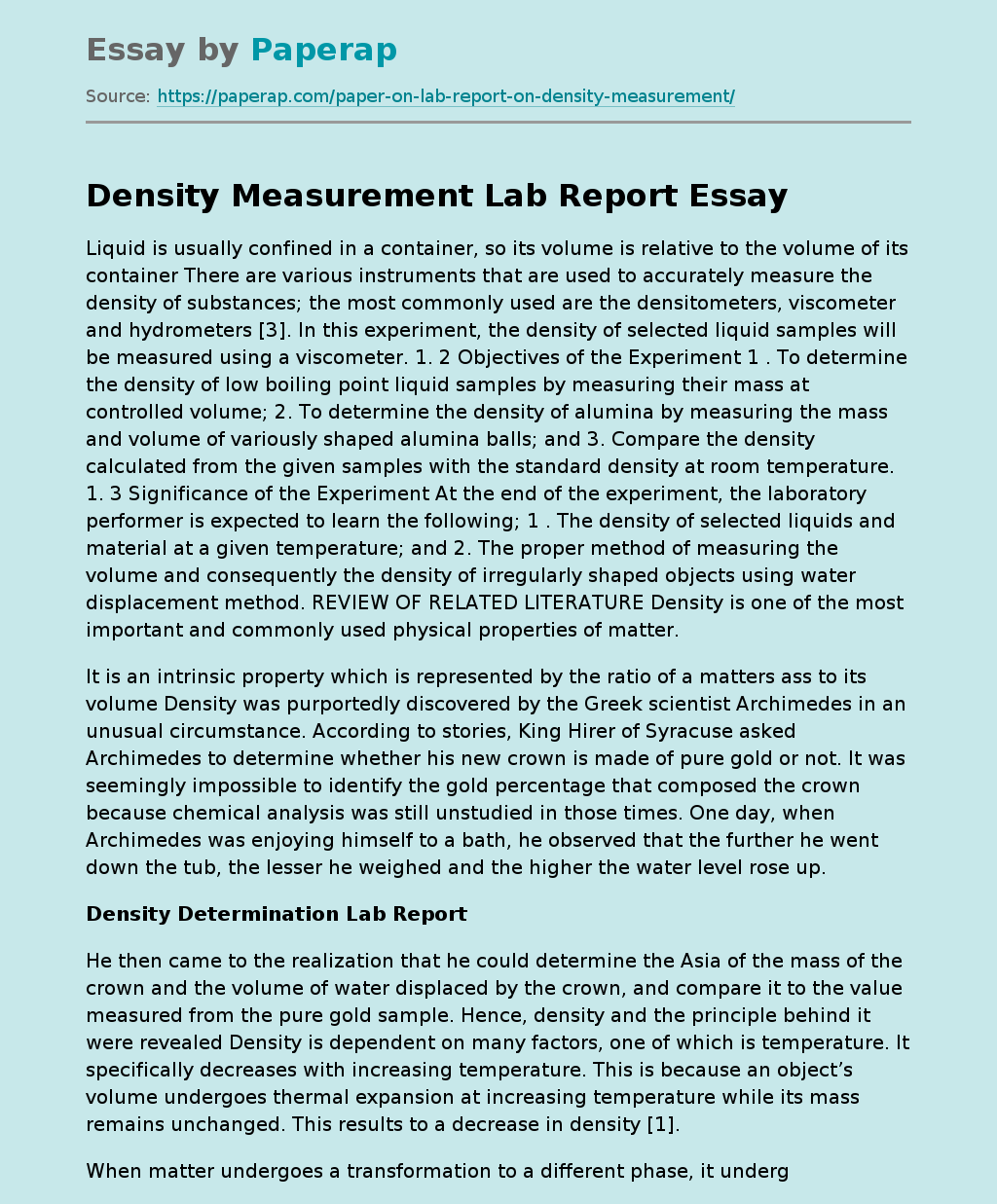Liquid is usually confined in a container, so its volume is relative to the volume of its container There are various instruments that are used to accurately measure the density of substances; the most commonly used are the densitometers, viscometer and hydrometers [3]. In this experiment, the density of selected liquid samples will be measured using a viscometer. 1. 2 Objectives of the Experiment 1 . To determine the density of low boiling point liquid samples by measuring their mass at controlled volume; 2. To determine the density of alumina by measuring the mass and volume of variously shaped alumina balls; and 3.
Compare the density calculated from the given samples with the standard density at room temperature. 1. 3 Significance of the Experiment At the end of the experiment, the laboratory performer is expected to learn the following; 1 . The density of selected liquids and material at a given temperature; and 2. The proper method of measuring the volume and consequently the density of irregularly shaped objects using water displacement method.
REVIEW OF RELATED LITERATURE Density is one of the most important and commonly used physical properties of matter.
It is an intrinsic property which is represented by the ratio of a matters ass to its volume Density was purportedly discovered by the Greek scientist Archimedes in an unusual circumstance. According to stories, King Hirer of Syracuse asked Archimedes to determine whether his new crown is made of pure gold or not. It was seemingly impossible to identify the gold percentage that composed the crown because chemical analysis was still unstudied in those times.
One day, when Archimedes was enjoying himself to a bath, he observed that the further he went down the tub, the lesser he weighed and the higher the water level rose up.
Density Determination Lab Report
He then came to the realization that he could determine the Asia of the mass of the crown and the volume of water displaced by the crown, and compare it to the value measured from the pure gold sample. Hence, density and the principle behind it were revealed Density is dependent on many factors, one of which is temperature. It specifically decreases with increasing temperature. This is because an object’s volume undergoes thermal expansion at increasing temperature while its mass remains unchanged. This results to a decrease in density [1].
When matter undergoes a transformation to a different phase, it undergoes an abrupt change in density. The transition of molecules of matter to a less random form, say from gas to liquid or from liquid to solid, causes a drastic increase in the density. However, there are substances which behave differently from this density-temperature relationship, by which one example is water. The greatest density achieved by water molecules are at ICC. At temperatures higher or lower than ICC, its density slowly decreases. This makes ice less dense than water, a property not commonly exhibited by other liquids METHODOLOGY 3. Materials A. Viscometer, 25-ml B. Graduated cylinder, 1000-ml C. Graduated cylinder, 250-ml D. Beaker, 250-ml E. Low boiling point liquids (acetone, 70% solution ethyl alcohol, 70% solution spoilsport alcohol), 30 ml F. Distilled water G. Two sets of alumina balls (small cylindrical, large cylindrical and large spherical balls) H. Analytical balance beam 3. 2 Determining the Mass of a 25-ml Liquid [5] A. Carefully clean and dry the viscometer. B. Weigh the empty viscometer and its stopper in the balance beam and record the mass. C.
Fill the viscometer with the liquid sample up to its brim, and insert the stopper carefully. Wipe off any excess fluid on the sides of the hygrometer with a clean cloth or tissue. D. Balance and record the mass of the filled viscometer plus the stopper. E. Empty the contents of the viscometer in a clean beaker. F. Make three trials for each liquid. 3. 3 Determining the Mass and Volume of Alumina Balls [5] A. Measure the mass of each alumina ball in the balance beam. B. Add distilled water to the graduated cylinder and record its initial volume. C.
Density Measurement Lab Report. (2019, Dec 05). Retrieved from https://paperap.com/paper-on-lab-report-on-density-measurement/

